Roofing Companies Woodlawn
Top 10 Roofing Services in Woodlawn
Get up to 3 Roofers quotes for your project today! Compare profiles, reviews, accreditations, portfolio, etc... and choose the best service.

Southern Roofing and Restoration
520 reviewsRoanoke, USAt Southern Roofing and Restoration, our mission is to deliver premium roofing, siding, window, and construction services in Southern Virginia. We are dedicated to excellence in craftsmanship and customer satisfaction. We bring our expertise to multiple construction sectors, developing the industry's future and redefining what is possible, one project at a time. From meticulous planning and expert construction to timely delivery, we are dedicated to delivering top-tier roofing, siding, and window services to Southern Virginia.
- Services
- Why Us?
- Gallery
Get Quote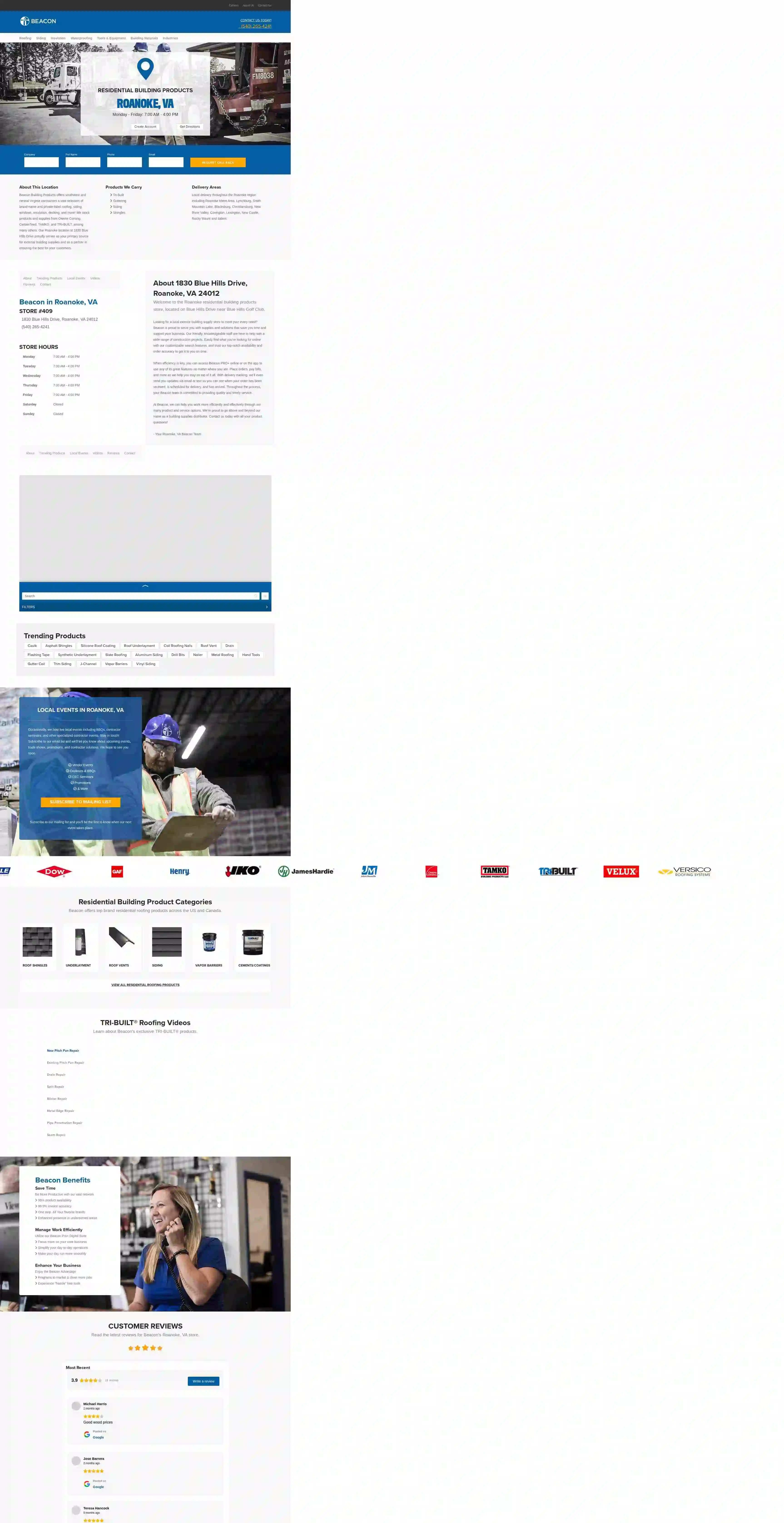
Beacon Building Products
3.817 reviews1830 Blue Hills Drive, Roanoke, 24012, USBeacon Building Products offers southwest and central Virginia contractors a vast selection of brand-name and private-label roofing, siding, windows, insulation, decking, and more! We stock products and supplies from Owens Corning, CertainTeed, TAMKO, and TRI-BUILT, among many others. Our Roanoke location at 1830 Blue Hills Drive proudly serves as your primary source for external building supplies and as a partner in ensuring the best for your customers.
- Services
- Why Us?
- Gallery
Get Quote
Conley Brothers Inc
58 reviews628 East end Ave, Norfolk, 23504, USConley Brothers, Inc. is a family-owned and operated masonry company with over 55 years of experience serving the Hampton Roads area. We specialize in both residential and commercial masonry, offering a wide range of services including restoration, repair, and new construction. Our team of skilled mason workers is dedicated to providing high-quality craftsmanship and exceptional customer service. We pride ourselves on using only the highest-quality materials and state-of-the-art techniques to ensure that your property looks its best. Conley Brothers has a long history of serving the Hampton Roads community, with projects spanning from residential homes to large commercial buildings. We are proud to be a SWAM certified and HUBZone business, and we offer a 10% discount to all first responders and military personnel.
- Services
- Why Us?
- Our Team
- Testimonials
- Gallery
Get Quote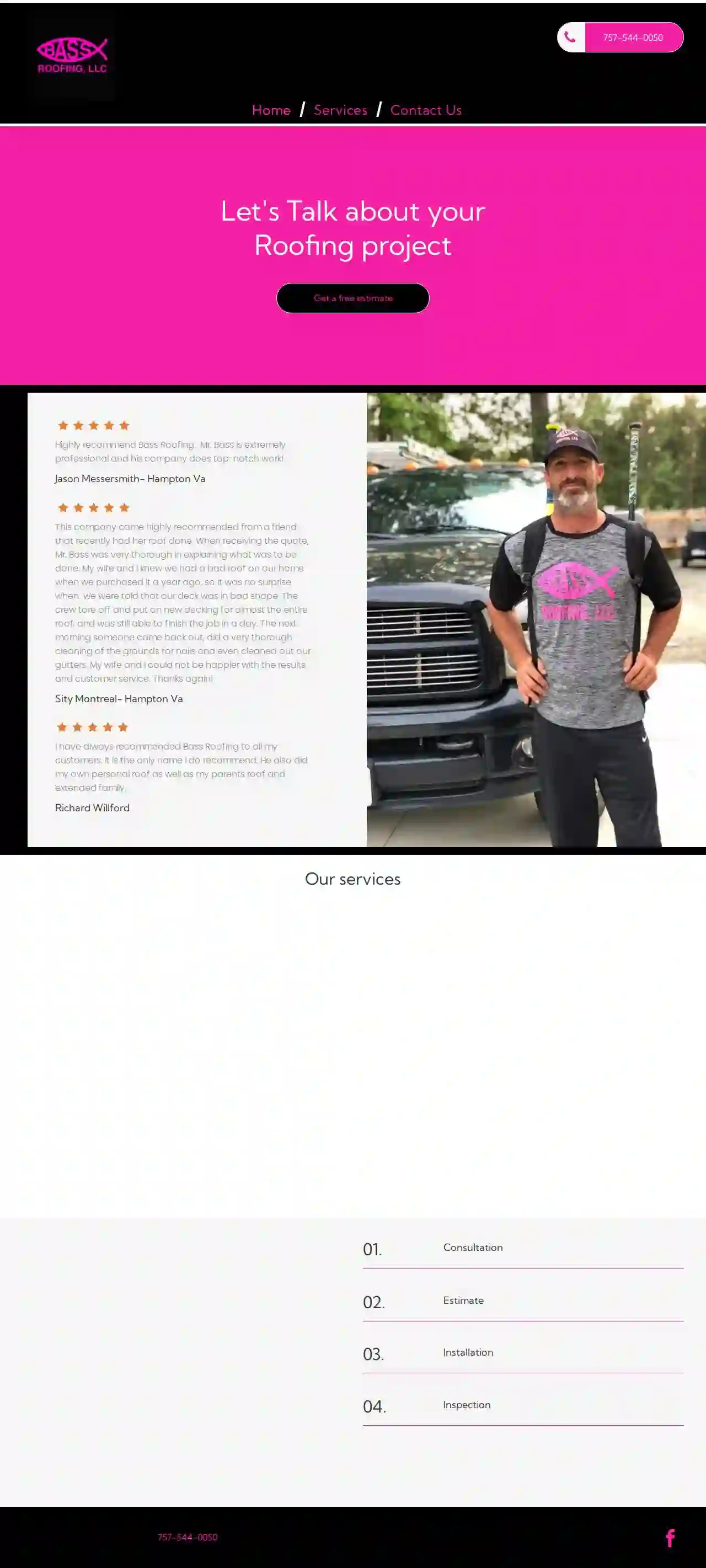
Bass Roofing LLC
4.829 reviewsHampton Va, Hampton, USLet's Talk about your Roofing project Get a free estimate Group 4 Highly recommend Bass Roofing. Mr. Bass is extremely professional and his company does top-notch work! Jason Messersmith- Hampton Va Group 4 This company came highly recommended from a friend that recently had her roof done. When receiving the quote, Mr. Bass was very thorough in explaining what was to be done. My wife and I knew we had a bad roof on our home when we purchased it a year ago, so it was no surprise when we were told that our deck was in bad shape. The crew tore off and put on new decking for almost the entire roof, and was still able to finish the job in a day. The next morning someone came back out, did a very thorough cleaning of the grounds for nails and even cleaned out our gutters. My wife and I could not be happier with the results and customer service. Thanks again! Sity Montreal- Hampton Va Group 4 I have always recommended Bass Roofing to all my customers. It is the only name I do recommend. He also did my own personal roof as well as my parents roof and extended family. Richard Willford Our services Repair work We can repair your roof before it becomes a bigger problem. Our experts will identify the problem and fix it professionally. Free Inspection A roof inspector will be looking for leaks, unusual wear and tear, damage caused by windblown debris, organic growth issues, and problems that may have occurred during shingle installation or subsequent repairs. Ultimately, a roof inspection gets broken into four facets: structure, materials, interiors, and workmanship. New Roof Installation All New Roof installations are fully custom and done to the final detail of our customers wants. We work with all manufacturers of shingles, rubber membranes, and we'll work together to make your roof look exactly that way you're thinking. Commercial Roofing We specialize in shingles, flat roofs, single-ply membranes, structural metal panels, modified bitumen, roof coatings, fabrication & on-site, roll forming, standing seam metal, cedar shakes, slate, tin & copper, and insurance claims. We understand the importance of a roof in keeping safe and dry. So give us a call today to let us know what we can do to keep the roof over your head.
- Services
- Why Us?
- Our Team
- Testimonials
- Gallery
Get Quote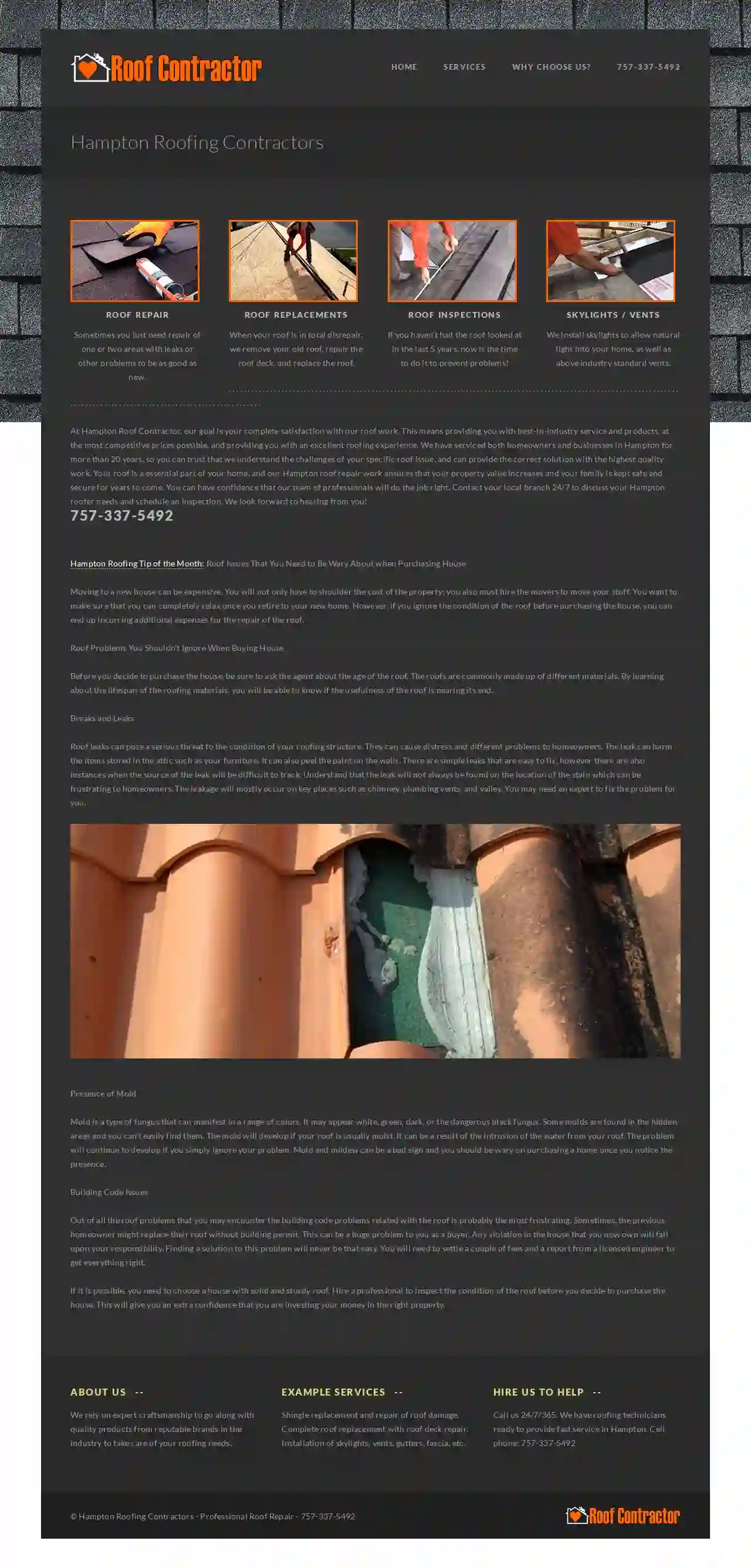
Hampton Roofing Contractors
Hampton, USAt Hampton Roof Contractor, our goal is your complete satisfaction with our roof work. This means providing you with best-in-industry service and products, at the most competitive prices possible, and providing you with an excellent roofing experience. We have serviced both homeowners and businesses in Hampton for more than 20 years, so you can trust that we understand the challenges of your specific roof issue, and can provide the correct solution with the highest quality work. Your roof is a essential part of your home, and our roofing work ensures that your property value increases and your family is kept safe and secure for years to come. You can have confidence that our team of professionals will do the job right. Contact your local branch 24/7 to discuss your Hampton roofer needs and schedule an inspection. We look forward to hearing from you! 757-337-5492
- Services
- Why Us?
- Gallery
Get Quote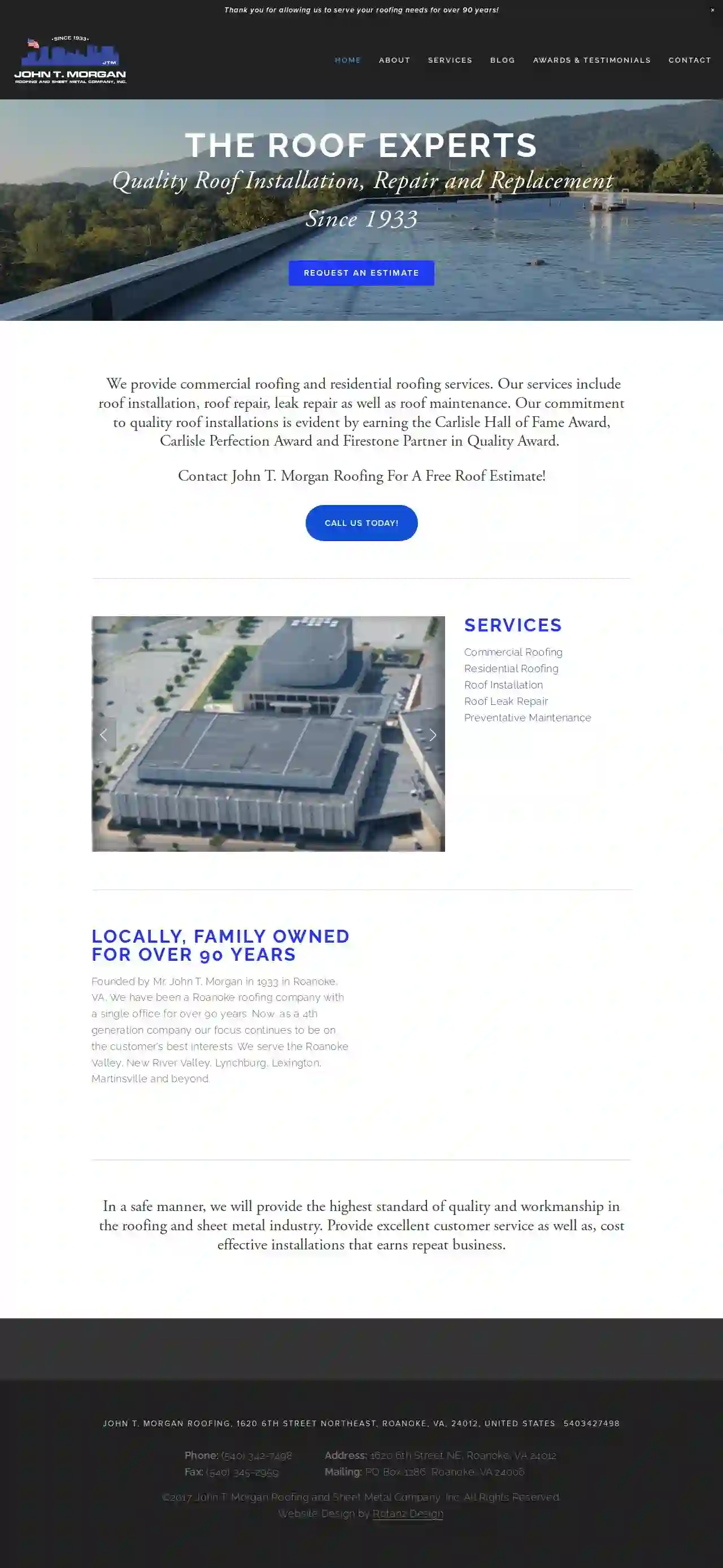
John T. Morgan Roofing & Sheet Metal
4.86 reviews1620 6th Street NE, Roanoke, 24012, US- Services
- Why Us?
- Accreditations
- Our Team
- Gallery
Get Quote
Painter Roofing and Construction LLC
4.962 reviewsArlington, US- Services
- Why Us?
- Accreditations
- Gallery
Get Quote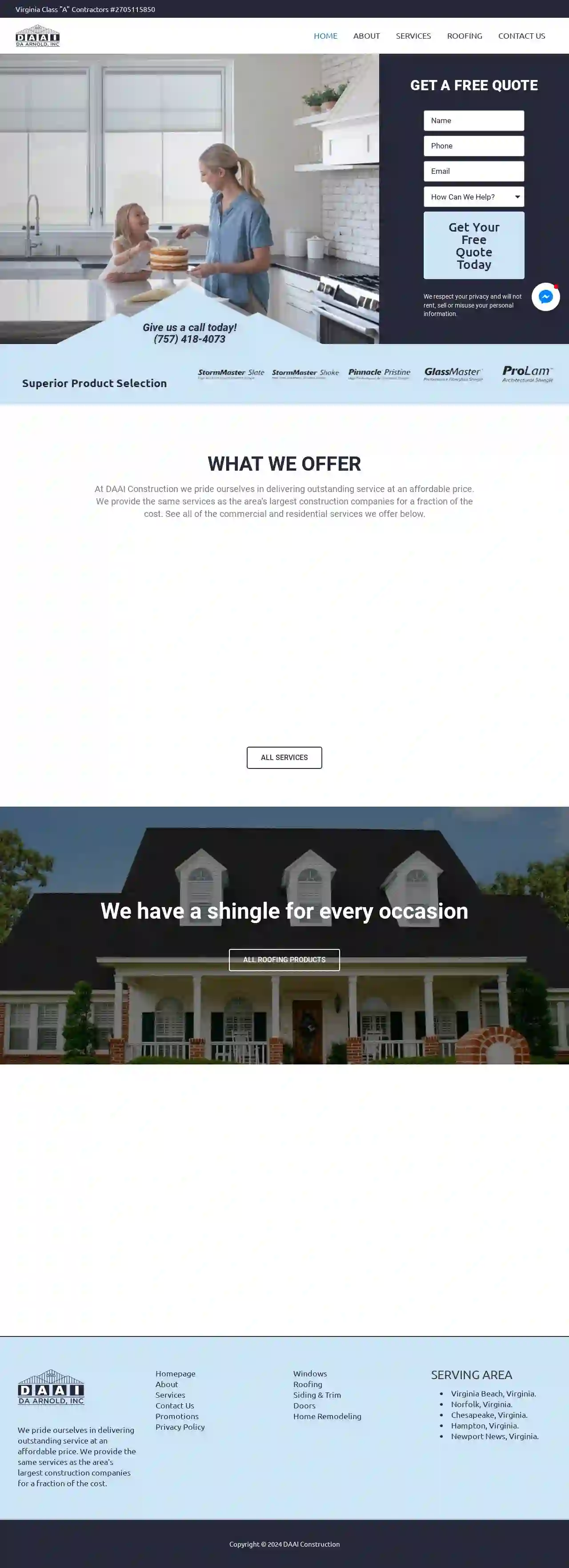
DA Arnold Inc
58 reviewsVirginia Beach, 23456, USAt DAAI Construction, we take pride in delivering exceptional service at an affordable price. We offer a comprehensive range of commercial and residential services, mirroring the quality of larger construction companies but at a fraction of the cost. Our team of experienced professionals is dedicated to ensuring your complete satisfaction with every project, from start to finish. We are a Class A contractor, fully committed to meeting your project requirements on time and within budget. With over 30 years of experience, we possess the knowledge, skills, and craftsmanship to handle any construction need. Whether you're looking to enhance your home's curb appeal with new windows, siding, or doors, or you need a complete roof replacement, DAAI Construction is your trusted partner. We understand that your home is your sanctuary, and we treat every project with the utmost care and attention to detail. Our commitment to quality workmanship and customer satisfaction is unwavering. Contact us today for a free consultation and let us help you bring your vision to life.
- Services
- Why Us?
- Gallery
Get Quote
Quality Tops Roofing
4.992 reviews5207 W ARKANSAS LN, Arlington, 76016, USQuality Tops Roofing Inc. is a reputable roofing contractor in the Dallas/Fort Worth Metroplex, providing top-quality roofing services for over 40 years. With a team of experienced professionals, we offer roof replacement, roof repair, storm damage, and free roofing inspection services. Our goal is to provide exceptional customer service, ensuring our customers' roofing needs are met with honesty, integrity, and friendliness. We are a member of Google Local and The Good Contractor's List, and our reviews are available on Angie's List, Google, Better Business Bureau, The Shepherd's Guide, and Facebook.
- Services
- Why Us?
- Our Team
- Testimonials
- Gallery
Get Quote
Matthew Roofing and Siding LLC
34 reviewsVirginia Beach, USAt Matthew Roofing and Siding LLC, we take pride in our ability to provide top-quality solutions for all your roofing and siding needs. With years of experience in the industry, our team of skilled professionals is committed to delivering unmatched craftsmanship and outstanding customer service. What sets us apart is our attention to detail and commitment to using only the highest quality materials that are built to withstand the harsh Virginia climate. Whether you need a new roof installed or siding replaced, we have the expertise to ensure a flawless and durable result. Our personalized approach means that we understand your unique needs and tailor our solutions to exceed your expectations. Contact us today to schedule a free estimate and let us take care of your roofing and siding needs.
- Services
- Why Us?
- Gallery
Get Quote
Over 17,196+ Roofers in our network
Our roofing pros operate in Woodlawn and beyond!
Roofyng.com has curated and vetted Top Roofers near Woodlawn. Find a trustworthy pro today.
Frequently Asked Questions About Roofing Companies
- Regular Inspections: Inspect your roof at least twice a year for signs of damage or wear and tear.
- Gutter Cleaning: Clean gutters and downspouts regularly to prevent clogs and ensure proper drainage.
- Tree Trimming: Trim overhanging branches to avoid damage from falling debris and reduce shade, preventing moss growth.
- Proper Ventilation: Ensure good attic ventilation to regulate temperature and moisture.
- Timely Repairs: Address any damage promptly to prevent escalation.
- Hot Climates: Opt for light-colored or reflective roofing materials to reduce heat absorption. Consider tile roofs for their thermal mass and heat resistance.
- Cold Climates: Ensure your roof has adequate insulation and ventilation to prevent ice dams and moisture buildup. Metal roofs can shed snow effectively.
- High-Wind Areas: Choose roofing systems with high wind ratings and properly installed hurricane straps or clips to enhance wind resistance.
- Areas with Heavy Rainfall: Ensure your roof has proper drainage and a waterproof membrane to prevent leaks.
- Choose Reflective Roofing Materials: Opt for light-colored shingles or metal roofing that reflects sunlight and reduces heat absorption.
- Install Proper Attic Insulation: Adequate insulation prevents heat loss in the winter and heat gain in the summer.
- Ensure Adequate Ventilation: Proper attic ventilation allows hot air to escape, reducing cooling costs and extending the lifespan of your roof.
- Consider a Radiant Barrier: In hot climates, a radiant barrier installed in the attic can reflect heat away from the roof, further reducing cooling needs.
- Age: If your roof is nearing or exceeding its expected lifespan, it's wise to consider replacement.
- Multiple Leaks: Several leaks or leaks that reappear after repairs suggest a widespread problem.
- Extensive Damage: Large areas of damaged, missing, or deteriorated roofing materials might be too costly or difficult to repair effectively.
- Sagging or Structural Issues: Sagging, deflection, or other structural issues indicate a compromised roof that needs replacement.
- Granule Loss (Asphalt Shingles): Significant granule loss indicates weathering and reduced protection.
- Curling or Buckling Shingles: Signifies age or improper ventilation.
- Increased Energy Bills: A poorly insulated roof can lead to higher heating and cooling costs.
How do I prevent roof damage?
How do I choose the right type of roof for my climate?
How can I make my new roof more energy-efficient?
What are the signs that my roof needs to be replaced?
How do I prevent roof damage?
- Regular Inspections: Inspect your roof at least twice a year for signs of damage or wear and tear.
- Gutter Cleaning: Clean gutters and downspouts regularly to prevent clogs and ensure proper drainage.
- Tree Trimming: Trim overhanging branches to avoid damage from falling debris and reduce shade, preventing moss growth.
- Proper Ventilation: Ensure good attic ventilation to regulate temperature and moisture.
- Timely Repairs: Address any damage promptly to prevent escalation.
How do I choose the right type of roof for my climate?
- Hot Climates: Opt for light-colored or reflective roofing materials to reduce heat absorption. Consider tile roofs for their thermal mass and heat resistance.
- Cold Climates: Ensure your roof has adequate insulation and ventilation to prevent ice dams and moisture buildup. Metal roofs can shed snow effectively.
- High-Wind Areas: Choose roofing systems with high wind ratings and properly installed hurricane straps or clips to enhance wind resistance.
- Areas with Heavy Rainfall: Ensure your roof has proper drainage and a waterproof membrane to prevent leaks.
How can I make my new roof more energy-efficient?
- Choose Reflective Roofing Materials: Opt for light-colored shingles or metal roofing that reflects sunlight and reduces heat absorption.
- Install Proper Attic Insulation: Adequate insulation prevents heat loss in the winter and heat gain in the summer.
- Ensure Adequate Ventilation: Proper attic ventilation allows hot air to escape, reducing cooling costs and extending the lifespan of your roof.
- Consider a Radiant Barrier: In hot climates, a radiant barrier installed in the attic can reflect heat away from the roof, further reducing cooling needs.
What are the signs that my roof needs to be replaced?
- Age: If your roof is nearing or exceeding its expected lifespan, it's wise to consider replacement.
- Multiple Leaks: Several leaks or leaks that reappear after repairs suggest a widespread problem.
- Extensive Damage: Large areas of damaged, missing, or deteriorated roofing materials might be too costly or difficult to repair effectively.
- Sagging or Structural Issues: Sagging, deflection, or other structural issues indicate a compromised roof that needs replacement.
- Granule Loss (Asphalt Shingles): Significant granule loss indicates weathering and reduced protection.
- Curling or Buckling Shingles: Signifies age or improper ventilation.
- Increased Energy Bills: A poorly insulated roof can lead to higher heating and cooling costs.